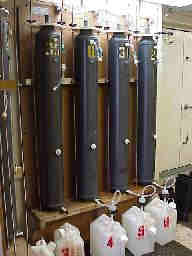| |
Science
Report:
Now that the
mooring recoveries are successfully behind us we are doing CTD work around
the clock. Time of day means very little when doing research at sea. The
ship's crew and scientists work every hour of the day so just as much
is going on at 3 AM as at 3 PM. Research ships are expensive to operate
so we all try and get the most out of every minute we are at sea.
In addition to using the
CTD data to map where the plumes are, most of the scientists on board
depend on the CTD to collect water samples for their analyses. Much of
the water is filtered through very fine filters to separate the tiny hydrothermal
particles that are suspended in the seawater. After collecting various
small samples of water from each of the 20 liter sampling bottles on the
CTD, the bottles are moved inside the ship and installed on a rack. Each
bottle is pressurized with nitrogen gas, and an outlet tube is attached
to a Teflon filter holder containing a small filter 37 mm in diameter.
The filter is a thin plastic film with holes only 0.0005 mm in diameter!
Pressure from the nitrogen gas forces seawater through the filter and
hydrothermal particles are trapped on its surface. The filters are then
dried and returned to the laboratory after the cruise. Later they will
be exposed to x-rays in a technique called "x-ray diffraction analysis"
that will reveal their chemical composition.
This analysis will provide
information on the seafloor environment of the hydrothermal vents. For
example, samples with high concentrations of copper come from vents that
are discharging fluids of very high temperatures, over 225 degrees Celsius.
Samples with high concentrations of sulfur suggest that biological activity
may be common in the vent field. For now, though, all we can do is carefully
collect these samples and wonder about what they might tell us when we
start the long process of analysis back at the laboratory.
|
|

Niskin bottles
lined up in the racks while water is being recovered into sampling containers.
|
|

